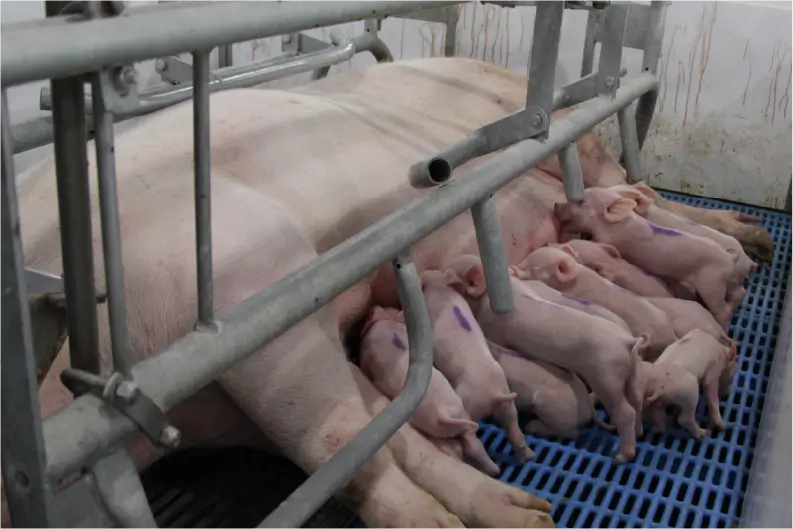By: Samuel Waititu Ph.D.
Monogastric Specialist
Fortified Nutrition Limited
Gestation is a long time in a sow’s life. It is characterized by a restricted feed allowance, restricted movement (if housed in stalls), and fetal development. Sow nutrition has a profound influence on conception and fetal survival during early gestation, and in late gestation, sow nutrition can influence reproductive performance. In this series of articles (Expectations Around Farrowing), I desire to review and stimulate discussions on the nutrition-based variables within our control during late gestation until about four days post-farrow. To the commercial pork producer, the gestation period veils hope and expectations, which make it worth the cost, patience and laborious duties employed in caring for the gestating sows until farrowing. Many things can go wrong in the gestation period and thus shatter these expectations. Hence, we need to discern the gestation-related challenges and take advantage of the nutritional opportunities that can eliminate or at least lessen their impact.
In this article, we will first explore low piglet birth weight. As we prepare to review these realities, I would like that we first demystify nutrition. Nutrition is not only about providing energy, water, and nutrients to the pigs, but it also entails aspects such as the source of the feed components, time of feeding and feed presentation design. Each of these factors complement each other, hence they must be purposely employed if our expectations are to be met.
Many producers do not weigh piglets at birth, instead they rely on what their eyes tell them when they walk the farrowing crates. Using eyes to determine optimum birth weight is not the best practice as it does not provide data that can estimate mortality risk and determine progress in the case of nutritional or management interventions. Nevertheless, no one likes to see small and low birth weight piglets because they have lower viability, growth, and survival to weaning. Feldpausch et al. (2019), postulated that the birth weight threshold for increased risk of preweaning mortality is ≤1.11 kg. Current research on highly prolific sows has provided convincing evidence that the increase in litter size is accompanied by a decrease in the average birth weight of piglets. For instance, Moreira et al (2020) demonstrated that an average increase of 4.8 piglets significantly reduced the average weight of total and born alive piglets by 9.67 and 12.4% respectively (Table 1).
Table 1: Effect of litter size on the variability of piglet birth weights.
† Coefficient of variation
The reduction of birth weights due to increased litter size cannot be fully eliminated by nutritional interventions because it is associated with uterine capacity. As litter size increases, more space is taken up by additional fetal placentas, hence, the reduced uterine space becomes a growth limiting resource that results in smaller piglets. Konig et al. (2021) determined the effect of prolificacy on the vitality of piglets immediately after birth using a vitality score system from Baxter et al. (2008; Table 2).
Table 2: Vitality score according to Baxter et al. (2008)
In their study, Konig et al. (2021) used 14 Danish genetic sows and 12 German Saddleback sows, which gave birth to 265 and 154 piglet, respectively. Table 3 summarizes the litter traits of the two groups of sows.
Table 3: Gestation length and litter traits in sows of Danish genetic and German Saddleback
The piglet vitality scores 1 and 2 clearly show that the highly prolific Danish genetic sows had significantly more piglets that were less viable compared to German Saddleback sows (Table 4).
Table 4: Vitality of piglets born to Danish genetic and German Saddleback Sows
This observation is convincing evidence that prolificacy is directly associated with reduction in piglet vitality, hence, increased risk of pre-weaning mortality. In conclusion, as many producers turn to highly prolific sows, we expect reduced piglet birth weights and increased intra-litter piglet birth weight variation. Piglets with low birth weights (≤1.11 kg) have low livability and survival rates, hence they contribute to higher pre-weaning mortality rates. There is convincing evidence that prolificacy as a genetic selection tool with too much pressure is directly associated with lower birth weights. In the next issue, we will explore the risks that low piglet birth weights pose to the performance and profitability of a herd and the available nutritional interventions that can mitigate those risks.
References:
01. Feldpausch, Julie A., et al. “Birth weight threshold for identifying piglets at risk for preweaning mortality.” Translational Animal Science 3.2 (2019): 633-640.
02. König, Nicola Lea, et al. “An investigation into uterine capacity based on litter and placental characteristics in two sow lines with different prolificacy (Danish Landrace x Danish Yorkshire versus German Saddleback).” Reproduction in Domestic Animals 56.1 (2021): 34-45.
03. Moreira, Rennan Herculano Rufino, et al. “Variability of piglet birth weights: A systematic review and meta‐analysis.” Journal of animal physiology and animal nutrition 104.2 (2020): 657-666.
This article was written for the Spring 2024 Swine Grist. To read the whole Swine Grist, click the button below.

